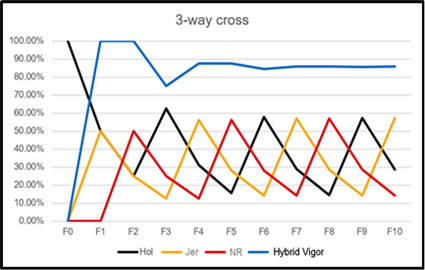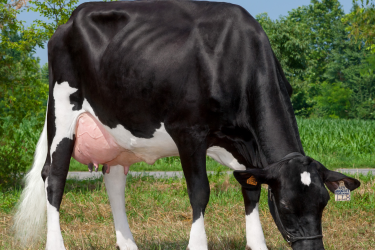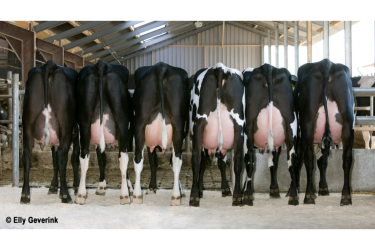How can HYVIG dairy crossbreeding give you more robust calves and cows?
There are two reasons.
First, HYVIG dairy crossbreeding can result in more robust calves and cows because of heterosis for cow and calf health, survival and reproduction. Heterosis is typically higher for health, survival and reproduction than for milk production traits, which means that crossbreeding will be more advantageous for health, survival and reproduction than for production traits. This effect is immediately seen in more vigorous, robust calves.
Secondly, because some breeds have better health, survival and reproduction than others. Breeds like the Norwegian Red have proven to transmit outstanding health, survival and reproductive performance. Incorporating these breeds in a crossbreeding program will introduce these genetics into a herd. It is also important to remember that these genetics will transmit to future offspring.
[READ: Crossbreeding Planning]
How does the milk, fat and protein production of HYVIG dairy crossbred cows compare with purebred Holstein cows?
As in any breeding program, milk, fat and protein production is dependent on the breed and sires used. Your HYVIG dairy crossbreeding advisor can help select the right program and sires to meet your goals. In general, milk volume may be slightly less than high-producing Holsteins, but fat and protein pounds will remain about the same because crossbreds produce a higher % of fat and protein.
How can HYVIG dairy crossbreeding lower replacement rates?
HYVIG dairy crossbreeding will generally result in lower replacement rates because of improved cow health, survival and reproduction due to heterosis and the breeds selected. The Norwegian Red has outstanding performance for health, survival and reproduction so, adding the Norwegian Red breed to a crossbreeding program will improve replacement rates and increase herd profitability.
How can HYVIG dairy crossbreeding improve reproductive performance?
There are two main reasons. First, heterosis for reproductive performance is very high. This benefit is gained whenever different breeds are crossed. However, this heterosis advantage is not transmitted to the next generation, so if you stop crossbreeding, the advantage is gone. Second, some breeds like Norwegian Reds, have concentrated on genetically improving reproductive performance for years. This has resulted in much better reproductive performance that is transmitted to their offspring and later generations. Like all genetic benefits, this advantage is built up and compounded in the herd.
How can HYVIG dairy crossbreeding increase bull calf value?
HYVIG dairy crossbreeding offers complementary breeds that have excellent calf survival and produce high-quality bull calves for meat. Bull calf income can significantly influence herd profitability, which makes bull calf survival is critical. Heterosis creates a calf that is very hardy and results in cows that are great mothers at calving. Having great maternal calving traits will also increase bull calf survival rates.
Plus, the increased fertility of crossbred cows can result in improved conception rates generating more opportunity to use dairy beef and therefore more bull calf value.
Reach out to us to learn more about the benefits of heterosis and dairy crossbreeding.






